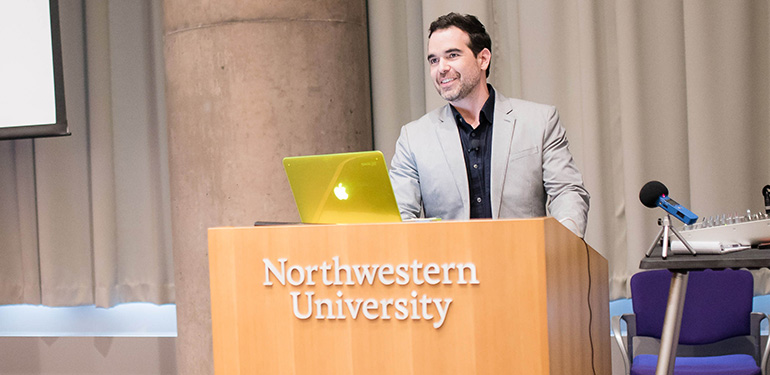Artist-at-Large Program
Dario Robleto: Artist-at-Large
In spring 2018, Northwestern Engineering and the Block Museum of Art hosted the artist Dario Robleto at Northwestern to launch a new Artist-at-Large Program, joining other activities organized by the McCormick School of Engineering as part of its ongoing Art and Engineering Initiative. The Artist-at-Large Program brings contemporary artists to campus for in-depth exchanges with faculty and students.
Dario Robleto, whose work is born out of cross-disciplinary research and collaboration, is uniquely positioned to serve as the initiative’s first artist. Over the last 20 years, Robleto’s work has explored the intersections of music, popular culture, language, storytelling, and the histories of science and war. He draws upon unconventional materials spanning from archival materials, to meteorite, to heartbeat recordings from the 19th century. A self-proclaimed “citizen-scientist,” Robleto pursues deep collaborations with experts across fields of inquiry spanning astrophysics, cardiology, glaciology, and neuroscience. He has even been an artist-in-residence at the SETI Institute.
Artist-at-Large Program
The Northwestern University Artist-at-Large Program grew out of a series of campus artist visits during 2016-2017 hosted by the Block Museum and Northwestern Engineering. Each invited artist delivered a series of lectures and met with faculty during two- to five-day visits. The goal was to discover intersections between the interests of the artists and those of Northwestern faculty, and learn how they might inspire each other’s thinking. Artists met with faculty in robotics, computer science, synthetic biology, and nanotechnology, along with bioethics, poetry, and art history (among many others).
The goals of the Artist-At-Large Program are to:
- Expose faculty and students to the artistic process, first-hand, through events, artist-led activities and conversations, and collaborative projects;
- Offer experiential learning opportunities to students and opportunities to develop new approaches to teaching for faculty;
- Inspire artists’ creativity through access to McCormick’s faculty and students, its resources, facilities, and scientific research and processes; as well as the wide range of offerings of a major research university located in a world-class cultural capital;
- Facilitate collaboration and intersections between the Block, McCormick, and other Northwestern schools, academic departments, and programs.
The Artist-at-Large Program reflects Northwestern’s commitment to creating partnerships across the University and to projects that take place outside the Museum’s galleries.
The Block’s Public Practice Program encourages art encounters across Northwestern University and its surrounding communities. Engaging the people, location, history, research, facilities, libraries, and laboratories surrounding the museum, public practices projects offer first-hand experience of the creative process. Taking the form of works of art, workshops, performances, publications, and projects, public practice at the Block Museum grows out of campus and community collaborations.
Dario Robleto at Northwestern
In spring of 2018, Robleto embedded himself within Northwestern’s Chicago and Evanston campuses. Robleto attended courses, visited laboratories, and met regularly with faculty and students from across McCormick and beyond — including astrophysics, bioethics, cardiology, computer science, neurology, the Segal Design Institute, sound studies, and synthetic biology, among others.
Highlights included a public presentation and workshop featuring Robleto and sound historian Patrick Feaster, along with ongoing conversations about ethics and poetics in science with Robleto, faculty from the Center for Synthetic Biology, and the Department of Bioethics and Medical Humanities. Robleto was in regular conversation with students from the Segal Design Institute.
A key part of the project included providing Robleto with a “hall pass” that provided him access to the brain trust of Northwestern Engineering and resources across campus — putting him in direct contact with people whose work could be catalytic for his artistic practice.
In winter 2023, the Block Museum and McCormick will present an original exhibition of and publication on Robleto’s work, The Aorta of an Archivist.
More About Dario Robleto
Robleto has exhibited his work in museums and galleries across the United States, including at the Whitney Museum of American Art, Museum of Contemporary Art in San Diego, and the Menil Collection in Houston. In 2008, the Frances Young Tang Teaching Museum and Art Gallery at Skidmore College organized Alloy of Love, a 10-year survey exhibition of Robleto’s art. He has also served as visiting artist and lecturer at several universities and institutions, including Massachusetts Institute of Technology and the Hubble Space Telescope Science Institute.
He is the recipient of both the Joan Mitchell Foundation Grant (2007) and the USA Rasmuson Fellowship (2009). He has been a research fellow and artist-in-residence at institutions such as the Smithsonian Museum of American History (2011); Rice University (2013-14); The Menil Collection (2014); and the Robert Rauschenberg Foundation (2017). In 2016 and 2017 he was a co-organizer of the International Conference on Mobile Brain-Body Imaging and the Neuroscience of Art, Innovation, and Creativity in Cancun, Mexico, and Valencia, Spain. Robleto’s work was featured in the 2017 Block Museum of Art exhibition “If You Remember, I’ll Remember.”
In 2015 Robleto joined a distinguished team of scientists as the artistic consultant to “Breakthrough Message,” a multinational effort that aims to encourage intellectual and technical debate about how and what to communicate if the current search for intelligent beings beyond Earth is successful. He was appointed artist-in-residence in neuroaesthetics at the University of Houston’s Cullen College of Engineering and at the SETI Institute in Mountain View, California. In 2016, he was named as the Texas State Artist Laureate, and he currently sits on the board of advisers of the Nasher Museum of Art at Duke University.
